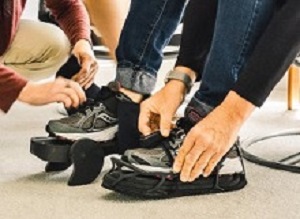Following successful clinical trials in the US, a therapeutic shoe engineered to improve stroke recovery is expected to be available commercially by the end of the year.
Clinical trials have been completed on the US patented iStride device, which is licensed by Moterum, a start-up company located in the University of South Florida (USF) Research Park.
Stroke sufferers experience muscle weakness or partial paralysis on one side of the body, which greatly impacts how they walk, known as gait. Gait asymmetry is associated with poor balance, a major cause of degenerative issues that make individuals more susceptible to falls and injuries.
The iStride device is strapped over the shoe of the good leg and generates a backwards motion, exaggerating the existing step, making it harder to walk while wearing the shoe. The awkward movement strengthens the stroke-impacted leg, allowing gait to become more symmetrical once the shoe is removed. The impaired foot wears a matching shoe that remains stationary.
"The backward motion of the shoe is generated passively by redirecting the wearer's downward force during stance phase. Since the motion is generated by the wearer's force, the person is in control, which allows easier adaptation to the motion," said developer Dr Kyle Reed, associate professor of mechanical engineering at USF. "Unlike many of the existing gait rehabilitation devices, this device is passive, portable, wearable and does not require any external energy."
"The importance of over-ground gait training has been emphasized in previous studies," said Dr Seok Hun Kim, research collaborator and associate professor in the School of Physical Therapy and Rehabilitation Sciences in the USF Health Morsani College of Medicine. "However, the training options available after stroke are very limited. This novel device allows gait rehabilitation in the environment of daily activities."
The trial included six people between ages 57 and 74 who suffered a cerebral stroke at least one-year prior to the study. They all had asymmetry large enough to impact their walking ability. Each received twelve, 30-minute gait training sessions for four weeks. With guidance from a physical therapist, the patients' gait symmetry and functional walking were measured using the ProtoKinetics Zeno Walkway system in the Human Functional Performance Laboratory at USF.
All participants improved their gait's symmetry and speed. That includes how long it takes to stand up from a sitting position and walk, as well as how long it takes to walk to a specific location and distance travelled within six minutes. Four improved the percentage of time spent in a gait cycle with both feet simultaneously planted on the ground, known as double limb support. As far as the other two that didn't improve, one started the study with severe impairment, while the other was highly functional. It's also important to note that three participants joined the study limited to walking in their homes. Following the trial, two of them could successfully navigate public venues.
Reed and Kim compared their method to a previous study conducted on split-belt treadmill training (SBT), which is used to help stroke patients improve their gait. The equipment allows the legs to move at different speeds, forcing the patient to compensate in order to remain on the treadmill. While the SBT improves certain aspects of gait, unlike the iStride, it doesn't strengthen double limb support. That research concluded only about 60% of patients trained on the SBT corrected their gait when walking in a normal environment.
Walking is context dependent where visual cues impact how quickly one tries to move, and in what direction. The iStride allows patients to adjust accordingly. Movement on a treadmill is predictable and provides individuals a static scene.
Since patients are often disappointed in their progress after being discharged from rehabilitation, the iStride's portability allows patients to relearn to walk in a typical setting more often and for a longer duration.
Reed and his collaborators are now working on a home-based clinical trial with 21 participants and expects to publish results within the next year. He recently received a Fulbright scholarship to conduct research at Hong Kong Polytechnic University. He's working in the rehabilitation sciences and biomedical engineering departments throughout the 2019-2020 academic year.
Abstract
Background: Gait impairment is a common consequence of stroke and typically involves a hemiparetic or asymmetric walking pattern. Asymmetric gait patterns are correlated with decreased gait velocity and efficiency as well as increased susceptibility to serious falls and injuries.
Research Question: This paper presents an innovative device worn on a foot for gait rehabilitation post stroke. The device generates a backward motion to the foot, which is designed to exaggerate the existing step length asymmetry while walking over ground. We hypothesize this motion will decrease gait asymmetry and improve functional walking in individuals with chronic stroke.
Methods: Six participants with chronic stroke, more than one year post stroke, received four weeks of gait training with three sessions per week. Each session included 30 min of walking over ground using the wearable device. Gait symmetry and functional walking were assessed before and after training.
Results: All participants improved step length symmetry, and four participants improved double limb support symmetry. All participants improved on all three functional outcomes (gait velocity, Timed Up and Go Test, and 6-Minute Walk Test), and five participants improved beyond the minimal detectable change or meaningful change in at least one functional outcome.
Conclusion: The results indicate that the presented device may help improve stroke patients’ walking ability and warrant further study. A gait training approach using this new device may enable and expand long-term continuous gait rehabilitation outside the clinic following stroke.
Authors
Seok Hun Kim, David E Huizenga, Ismet Handzic, Rebecca Edgeworth Ditwiler, Matthew Lazinski, Tyagi Ramakrishnan, Andrea Bozeman, David Z Rose, Kyle B Reed
[link url="https://www.usf.edu/news/2019/stroke-patients-relearning-how-to-walk-with-peculiar-shoe.aspx"]University of South Florida material[/link]
[link url="https://jneuroengrehab.biomedcentral.com/articles/10.1186/s12984-019-0569-x"]Journal of NeuroEngineering and Rehabilitation abstract[/link]

